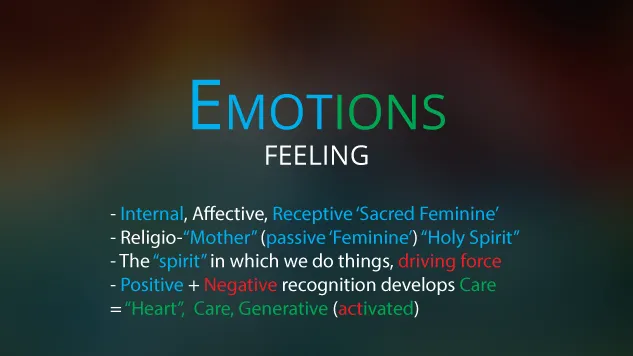The internal realm of consciousness is where the internal expressions of thoughts and emotions reside, compared to actions which are the external expression of consciousness. The word “spirit” is symbolically associated with consciousness, the soul, the unseen, and the immaterial. Consciousness is an unseen capacity, presumably immaterial. The internal expressions of consciousness of thought and emotion are unseen as well.

The internal realm is symbolically the “spiritual” realm where thoughts and emotions feedback upon each other. Emotion is result of conscious or unconscious result of thoughts and meaning which are expressed as feeling. Thoughts are a form of information, and the emotions are a response to our thoughts or the information we input from our environment. This processing of information can be conscious or unconscious where we response emotionally in an instant without consciously thinking about what happened.
Something can frighten us, but we aren’t thinking consciously about it when we respond emotionally with fright. While thinking about a past experience can being us joy or sadness. Our emotional responses can further stimulate our thinking about that emotion, how it arose, or other things. There are many variations to this feedback between thought and emotion.
Emotions are blue because they are part of the internal manifestations of consciousness, but also because they are receptive or passive and represented by and symbolize the feminine qualities. Emotions are also symbolized through the word “heart” which is used as a reference due to its location within the middle of our body. The word for heart in French is “coeur”, which has its etymological roots in the word “core”.
Green is in the middle between blue and red in the color spectrum. In the trinity of consciousness, emotions are in the middle between thoughts and actions, so they aptly fit the green color in this symbolic respect.
Our emotions, desires and what we care to do (good or bad/evil) will generate a driving force within us that motivates us and eventually leads us to act. Thoughts can be plentiful, but the emotions get us moving to do something. Care is the generator at our core essence that can have us invest more time and energy into thinking and also eventually care to act on what we think or know. This is how emotions or care is symbolized as “spirit”, as the “spirit in which we do things”, the motivational force that drives us to act and behave in certain ways (good or bad, right or wrong).
To be in the “heart”, to act of the “heart” or to “have a heart”, is to act in ways that are caring. It tied to doing an act of good. Or to not doing wrongs. To have truer care and generate in an activated holistic capacity means we have both the recognition of the positive and negative within ourselves and the world.
To know not to do something wrong requires to know that which is wrong in order to choose not to do it. This is conscience, to have the knowledge of the difference between right and wrong, and choose the right. Knowledge of what is right vs. wrong, moral vs. immoral, will develop our true care and concern for what is going on in the world. It will drive and motivate us to want to know what wrongs we do so as to stop doing them. Who would still choose to do harm when they are aware of what they’re doing? Such a person wouldn’t truly care about right vs. wrong, and wouldn’t be acting from the “heart” so to speak.
True care leads to our motivation to learn more truth, so that we can empower ourselves to be in a position of understanding, to act in the wisdom of right-action. True care involves the care for truth, and certainly moral truth.
Emotions are internal, yet are affective instead of cognitive despite requiring cognition in order to apply meaning and valuation as an emotion. Thoughts and emotions are part of a properly functioning consciousness. But emotions are the aspect that affect us the most, which is why the study of emotions is called the affective sciences, while the study of our thoughts is part of the cognitive sciences.
Relating this back to the symbolism of the religious trinity, the internal passive feminine is the religious mother figure which contrasts the internal active masculine of the religious father figure. This is represented as the “Holy Spirit” in the Christian trinity. The “spirit” is symbolic of the internal, unseen, formless, nonphysical and metaphysical motivational generative essence of our consciousness itself. Part of our core essence, or our “spirit” so to speak, is to strive to be more of that essence, to actualize that essence, to be more “spiritual”, which is to be more moral. This is what I consider to be a core purpose in life. To not do wrongs is at the core of what it means to be human.
Our emotions act as the symbolic “Holy Spirit” which moves us to do things as the driving motivational force in our lives. Our saliency towards the importance of things is how we value, and this is our desire or care to do something or not.
